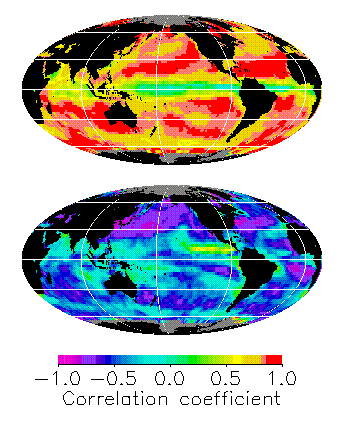
| |||||
|
|
|
|
|
|
|
|
|
|
|
|
|
|

The distributions of correlation coefficient between monthly-mean sea
surface temperature tendency (time differential) and 7 years of surface
solar irradiance (upper figure) and 4 years of latent heat flux (lower figure)
indicate that solar heating and evaporative cooling have a strong influence on
the seasonal variation of sea surface temperature over most of the ocean. The
low correlation along the equatorial waveguide in the upper figure delineate
the region where ocean dynamic is more important than surface heating.
The solar irradiance is derived from cloud information provided by the
International Satellite Cloud Climatology Project (ISCCP) and the
latent heat flux is derived using wind and humidity from the Special
Sensor Microwave Imager (SSMI) and sea surface temperature from the
Advanced Very High Resolution Radiometer
(AVHRR). A combination of satellite data available from the Earth
Observing System Data and Information System (EOSDIS)
help to provide unprecedented visualization of
the thermodynamics coupling of the global ocean and atmosphere. Details
can be found in Liu, et al. (J. Geophys. Res., 99, 12623-12637, 1994)
| PRIVACY | | IMAGE POLICY |
Webmaster: Xiaosu Xie
|